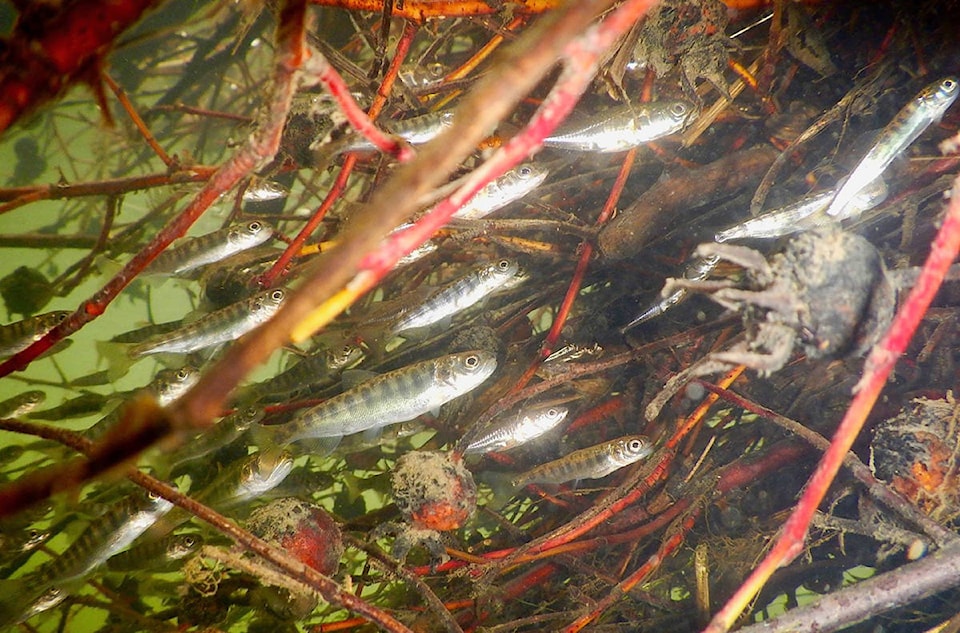“That’s pretty shocking and pretty scary. This is going to change our minds this year.”
That’s what Parker Jefferson and other members of the Cowichan River Watershed Board are finding, after examining the results of a study of chinook smolts, which was carried out during last summer’s drought.
“The results were really eye-opening,” Jefferson said.
He’s part of committees that keep an eye on river flows and fish.
They were aware, even in the spring of 2016, that any decision to reduce flows would be tough on the fish.
“We have always known intuitively that May and June are times when you don’t want to have a minimal flow in the river because all of the fry are out-migrating. The little guys trying to get down to the ocean would have no bushes by the side of the river to hide in as they usually do. There’d only be the main channel open to them and that’s where all the predators hang out.
“But, last year, on May 28, we decided we have to go to 4.5 metres a second, which is an absolute trickle if it ran at all,” he said.
As of a report released in mid-March, they now know what they did by reducing the flow at that time.
“It looks like we destroyed a large portion of the out-migrating chinook smolts by doing that.”
It turns out, the B.C. Conservation Foundation, with biologist Kevin Pellett, was funded to do a study right at that time on just this chinook predation.
He presented the results at the Cowichan Stewardship Roundtable on March 16.
Thousands of out-migrating chinook — both wild and hatchery bred — were caught at Little Beach, individually tagged and then released at various points down the Cowichan River.
The study’s results were great cause for concern, according to Jefferson.
Antennas were set up at several places on the river, running across the river, to record which fish passed by.
For optimum outmigration, especially of chinook, to the ocean, “We like to see between 15-20 or even 25 cubic metres per second during that time,” Jefferson said.
So there they were, in May, with the river flow reduced. But they had been forced to do something to hold water in reserve in the lake.
“It had looked like, if we did the 20 or 25 cubic metres per second we were wanting in May or June, we would have reached zero storage somewhere around the end of July without any rain. And that was scary. So we thought: we just can’t do that. We’ve got to go down to 4.5.
“And now we know what happened when we did that,” he said.
“It’s only one study and we’re going to repeat it this year. All we do know is that for every kilometre of river cost you one and a half to two per cent of the out-migrating smolts. Those fish just disappeared; they were eaten,” he said.
“With roughly 50 kilometres of river, it’s easy to do the math. A fish that enters the river at the top has almost zero chance he’s going to make it to the mouth.”
For 2017, they must re-examine their options but they have another option now.
“We will be very hestitant to go that low that early again, with the knowledge now that the backup is the pumping,” he said, referring to Catalyst’s experiment with bringing in big pumps to help lift the lake water over the weir if needed at the end of the dry summer.
“Last year, the pumping was a pipe dream. Tests last year have proven that pumping is a viable option we now know we have,” he said.
“I think it will allow us to take a bit more risk into consideration when we talk about our spring flows. And I’m going to be fighting very hard to make sure that everyone understands what we think happened last year.
“It looks like we did serious damage to that year’s class of fish. It doesn’t look like very many of them even made it to the ocean and that’s supposed to be where their trials and tribulations start. And the damage occurred in a time when they are starting to recover. It went from less than 2,000 fish in 2009 up to about 10,000 last year. They are coming back, but this is going to set that back quite a bit. We certainly can’t afford to do that two years in a row.
“But we now know what the deal is and what the cost is likely to be if we choose to really ramp the river down again that early in the year.”
Jefferson said he hopes Cowichan Lake residents who have been fighting the idea of storing more water in the lake will look again at what happened last summer.
“Now, we’re proceeding very slowly, trying to get the weir storage going. It would be just a slight increase in summer storage; it’s nowhere near where the water goes in the winter. If we had a metre, we’d be in so much better shape. And it’s got to happen.
“Now we see the damage that was done. We’ve got the actual science and that will hopefully help us to convince some of those dissenters,” he said.
